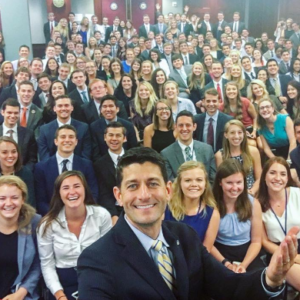Earlier this month, an Instagram selfie of Speaker of the House Paul Ryan was met with a torrent of criticism from social media and news outlets. The picture featured Ryan with an overwhelming large group of white Capitol Hill interns.
Immediately, people took to Twitter with the hashtag #housesowhite expressing their frustration over the lack of diversity on the Republican side at Capitol Hill. Several news articles also explored the lack of people of color interning for Republican office representatives. While this seemed shocking to some, the fact remains that Republicans are not the only ones who have this diversity problem.
Yes, a group of Democratic congressmen posted photos with a much more diverse group of interns, however, that doesn’t mean that the problem of diversity does not exist on both sides of the aisle. You will notice that the members of Congress with the most diverse staff and interns happen to be themselves from communities of color and underrepresented communities.
The problem is not JUST at Capitol Hill. Internships at nonprofits, policy think tanks, the federal government, media outlets are mostly held by upper middle-class white males. This trend is changing but not fast enough. Lingering race, gender and class prejudices continue to affect hiring and promotion processes. The current system of unpaid internships blocks entry to many careers that influence change and power in this country.
I know this from personal experience. When I was a student attending the University of Denver in the late 1990s and early 2000s, I wanted a chance to intern in Washington, but I could not afford it. As a first-generation immigrant, I could barely put myself through school. I did not only work part time during the school year but I also worked full time during the summer to cover the cost of books and classes that were not covered by my scholarship or financial aid.
The cost of a summer internship was overwhelming. Back then, the cost for travel to D.C., room and board was about $4,000. Additionally, I was not “connected” in Washington, and my parents were not donors. Furthermore, internship placement programs were too expensive. Because these internships were for school credit, students had to pay the placement program and also their home school tuition for the credited hours.
If we added up all the program costs from back then, they’d cost on average $7,000. Today, these programs cost about $14,000, which does not include food or travel.
As Darren Walker from the Ford Foundation stated in a New York Times opinion article, “internships are not a privilege.” He is right! Internships are integral to getting your first job after graduating from college. These internships are usually a student’s chance to learn the nature of the work force environment and network with people in power in Washington.
So, if students from communities of color, low-income and immigrant communities continue to be excluded from internships and jobs, politics and government sectors will continue to serve the few elites. Policies and services will poorly meet the needs of Americans and innovation will stall.
To mock and chastise Speaker Ryan for posting his selfie is not the solution. The only way to bring about real change, and increase diversity, is for both political parties to recognize that there is a problem and make strides to fix that problem.
Here are some solutions to fix the problem:
—Foundations and corporations need to invest in organizations that provide internship placement, professional trainings, mentorships and tools for its participants to lead in the future.
—Nonprofits, think tanks, law offices, lobbying firm, ALL Hill offices (Republicans and Democrats), media outlets and federal government need to invest in their HR practices by embracing diversity and inclusion programs and hiring more diverse staff.
—Government agencies and Capitol Hill need to start paying their interns.

